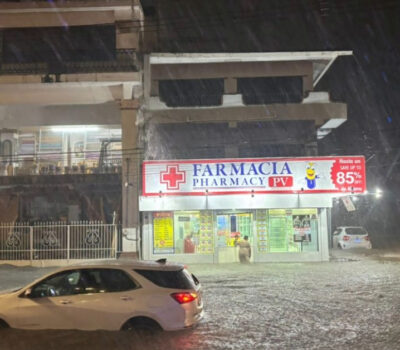A bee swarm attack injured eight people in Bahía de Banderas, prompting the closure of a pedestrian bridge near Lago Real. Authorities launched a multi-agency response to protect the public and safely relocate the bees.
A pedestrian bridge in Bahía de Banderas was closed to the public after a swarm of bees attacked passersby, stinging at least eight people. The incident occurred in front of the Lago Real shopping center and triggered an immediate response from local authorities, who cordoned off the area and shut down nearby public transportation stops.
The Bahía de Banderas Municipal Civil Protection Unit confirmed the temporary closure and stated that bus stops near the scene would be relocated later in the evening. Officials urged residents to avoid the area and not attempt to cross the bridge until the operation is complete.
A coordinated response involving the Ecology, Traffic, Citizen Security, and Civil Protection departments began shortly after the attack and is expected to continue through the weekend. The goal is to monitor the bees and relocate the swarm without harming the ecosystem.
While no one was seriously injured, the incident underscores the risk swarming bees can pose to public safety, especially in urban areas.
Bee stings and public risk
Most bee stings cause mild to moderate symptoms like pain, swelling, and redness. However, they can become dangerous—especially for people with allergies or in cases of mass stings. According to the U.S. Centers for Disease Control and Prevention (CDC), approximately 60 deaths occur annually in the United States due to stings from bees, wasps, and hornets.
From 2000 to 2017, the U.S. recorded 1,109 fatalities from such stings—an average of 62 per year. In Brazil, between 2009 and 2019, nearly 145,000 cases of bee stings were reported, resulting in 425 deaths—a fatality rate of roughly 0.29%.
In rare cases, mass envenomation can be fatal even without an allergic reaction. One notable case in India involved a 70-year-old man who died after being stung more than 500 times. These events, while uncommon, highlight the importance of treating swarm incidents as public health concerns.
Allergic reactions and anaphylaxis
The biggest danger from bee stings is anaphylaxis, a rapid and severe allergic reaction. It’s estimated that 5–10% of the population may experience systemic reactions to insect venom, and up to 3% are at risk of full-blown anaphylaxis.
Without treatment, anaphylaxis can cause airway obstruction, cardiac arrest, or death. However, with access to emergency epinephrine (commonly administered via EpiPen) and prompt medical care, the survival rate is extremely high.
Allergy specialists often recommend venom immunotherapy for patients who have had serious reactions. This treatment can reduce the risk of future severe reactions from 60% down to 2–3%.
What to do in case of a bee swarm
Health officials recommend the following precautions in areas where swarms may appear:
- Do not swat at bees. Sudden movements can provoke them further.
- Cover your face and run to shelter. A safe indoor space like a car or building is best.
- Call emergency services. Multiple stings or any signs of allergic reaction—such as difficulty breathing, facial swelling, or dizziness—require urgent medical care.
- Avoid perfumes or bright clothing. These can attract bees.
If you know you’re allergic to insect stings, always carry epinephrine and inform people around you of your condition.
Bridge to remain closed through weekend
As of now, the pedestrian bridge near Lago Real will stay closed while authorities continue efforts to safely remove the bees. Officials emphasized that the response is not only about public safety but also ecological preservation, as bees play a vital role in local biodiversity.
Residents are being asked to respect barriers and rerouted transit points while the operation continues. Updates will be issued through official channels once the area is safe to reopen.
A bee swarm attack injured eight people in Bahía de Banderas, prompting the closure of a pedestrian bridge near Lago Real . . .












